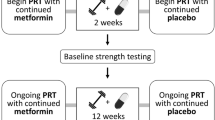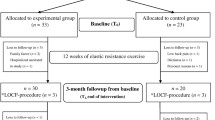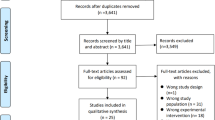Abstract
Objective
To examine the influence of intramuscular adipose tissue (IMAT) on muscle quality (MQ) changes in older adults after 12 weeks of exercise training.
Design
Prospective cohort design.
Setting
Academic health science center clinical exercise facility.
Participants
70 older (mean age 73.4 ± 6.3 years) adults with a history of falls.
Intervention
Resistance, endurance and balance exercise three times weekly for 12 weeks.
Measurements
Quadriceps strength was determined by maximum voluntary isometric contraction. An MRI of the thigh was used to determine cross-sectional area of lean tissue and IMAT. MQ was calculated as the force per unit area of lean tissue. Individuals were stratified into tertiles (Low IMAT, Middle IMAT, High IMAT) based on pre-IMAT levels. Changes in MQ, lean and IMAT were compared across groups.
Results
No significant changes in lean or IMAT occurred in any group with training. MQ increased only in the Low IMAT group. The Middle and High IMAT groups did not demonstrate a significant change in MQ following 12 weeks of training. Low IMAT, pre = 2.7 [0.6] post= 3.0 [0.6]; Middle IMAT, pre =2.54 [0.8] post =2.75 [0.7]; High IMAT, pre =2.6 [0.6] to post =2.5 [0.6].
Conclusion
High levels of thigh IMAT appear to blunt the adaptive MQ response to training. High levels of thigh IMAT may be a potential reason why some older adults do not change their MQ following training. Future research should confirm these results and determine why IMAT impairs MQ and the adaptive response to training in older adults.
Similar content being viewed by others
References
Goodpaster BH, Park SW, Harris TB, Kritchevsky SB, Nevitt M, Schwartz AV, Simonsick EM, Tylavsky FA, Visser M, Newman AB: The loss of skeletal muscle strength, mass, and quality in older adults: the health, aging and body composition study. J Gerontol A Biol Sci Med Sci. 2006, 61:1059–1064.
Frontera WR, Hughes VA, Fielding RA, Fiatarone MA, Evans WJ, Roubenoff R: Aging of skeletal muscle: a 12-yr longitudinal study. J Appl Physiol. 2000, 88:1321–1326.
Delmonico MJ, Harris TB, Visser M, Park SW, Conroy MB, Velasquez-Mieyer P, Boudreau R, Manini TM, Nevitt M, Newman AB, Goodpaster BH: Longitudinal study of muscle strength, quality, and adipose tissue infiltration. Am J Clin Nutr. 2009, 90:1579–1585.
Metter EJ, Lynch N, Conwit R, Lindle R, Tobin J, Hurley B: Muscle quality and age: cross-sectional and longitudinal comparisons. The journals of gerontology. Series A, Biological sciences and medical sciences. 1999, 54:B207–B218.
Goodpaster BH, Carlson CL, Visser M, Kelley DE, Scherzinger A, Harris TB, Stamm E, Newman AB: Attenuation of skeletal muscle and strength in the elderly: The Health ABC Study. J Appl Physiol. 2001, 90:2157–2165.
Visser M, Kritchevsky SB, Goodpaster BH, Newman AB, Nevitt M, Stamm E, Harris TB: Leg muscle mass and composition in relation to lower extremity performance in men and women aged 70 to 79: the health, aging and body composition study. J Am Geriatr Soc. 2002, 50:897–904.
Marcus RL, Addison O, Dibble LE, Foreman KB, Morrell G, LaStayo PC: Intramuscular Adipose Tissue, Sarcopenia and Mobility Function in Older Individuals. Journal of Aging Research. 2012, In Press:629637.
Hilton TN, Tuttle LJ, Bohnert KL, Mueller MJ, Sinacore DR: Excessive adipose tissue infiltration in skeletal muscle in individuals with obesity, diabetes mellitus, and peripheral neuropathy: association with performance and function. Phys Ther. 2008, 88:1336–1344.
Visser M, Goodpaster BH, Kritchevsky SB, Newman AB, Nevitt M, Rubin SM, Simonsick EM, Harris TB: Muscle mass, muscle strength, and muscle fat infiltration as predictors of incident mobility limitations in well-functioning older persons. J Gerontol A Biol Sci Med Sci. 2005, 60:324–333.
Lang T, Cauley JA, Tylavsky F, Bauer D, Cummings S, Harris TB: Computed tomographic measurements of thigh muscle cross-sectional area and attenuation coefficient predict hip fracture: the health, aging, and body composition study. J Bone Miner Res. 2010, 25:513–519.
Rodeheffer MS: Tipping the scale: muscle versus fat. Nature cell biology. 2010, 12:102–104.
Pedersen BK: The diseasome of physical inactivity—and the role of myokines in muscle—fat cross talk. J Physiol. 2009, 587:5559–5568.
Peterson MD, Liu D, Gordish-Dressman H, Hubal MJ, Pistilli E, Angelopoulos TJ, Clarkson PM, Moyna NM, Pescatello LS, Seip RL, Visich PS, Zoeller RF, Thompson PD, Devaney JM, Hoffman EP, Gordon PM: Adiposity attenuates muscle quality and the adaptive response to resistance exercise in non-obese, healthy adults. Int J Obes (Lond). 2010.
Bouchard C, Rankinen T: Individual differences in response to regular physical activity. Medicine and science in sports and exercise. 2001, 33:S446–S451; discussion S452–443.
Karavirta L, Hakkinen K, Kauhanen A, Arija-Blazquez A, Sillanpaa E, Rinkinen N, Hakkinen A: Individual responses to combined endurance and strength training in older adults. Medicine and science in sports and exercise. 2011, 43:484–490.
Goodpaster BH, Chomentowski P, Ward BK, Rossi A, Glynn NW, Delmonico MJ, Kritchevsky SB, Pahor M, Newman AB: Effects of physical activity on strength and skeletal muscle fat infiltration in older adults: a randomized controlled trial. J Appl Physiol. 2008, 105:1498–1503.
Marcus R, Addison O, Kidde J, Dibble L, Lastayo P: Skeletal muscle fat infiltration: Impact of age, inactivity, and exercise. The Journal of Nutrition, Health and Aging. 2010.
Marcus RL, Smith S, Morrell G, Addison O, Dibble LE, Wahoff-Stice D, Lastayo PC: Comparison of combined aerobic and high-force eccentric resistance exercise with aerobic exercise only for people with type 2 diabetes mellitus. Phys Ther. 2008, 88:1345–1354.
Beasley LE, Koster A, Newman AB, Javaid MK, Ferrucci L, Kritchevsky SB, Kuller LH, Pahor M, Schaap LA, Visser M, Rubin SM, Goodpaster BH, Harris TB: Inflammation and race and gender differences in computerized tomographymeasured adipose depots. Obesity (Silver Spring). 2009, 17:1062–1069.
Cesari M, Kritchevsky SB, Baumgartner RN, Atkinson HH, Penninx BW, Lenchik L, Palla SL, Ambrosius WT, Tracy RP, Pahor M: Sarcopenia, obesity, and inflammation—results from the Trial of Angiotensin Converting Enzyme Inhibition and Novel Cardiovascular Risk Factors study. Am J Clin Nutr. 2005, 82:428–434.
Ryan AS, Nicklas BJ: Reductions in plasma cytokine levels with weight loss improve insulin sensitivity in overweight and obese postmenopausal women. Diabetes Care. 2004, 27:1699–1705.
Schenk S, Saberi M, Olefsky JM: Insulin sensitivity: modulation by nutrients and inflammation. J Clin Invest. 2008, 118:2992–3002.
Bruunsgaard H, Bjerregaard E, Schroll M, Pedersen BK: Muscle strength after resistance training is inversely correlated with baseline levels of soluble tumor necrosis factor receptors in the oldest old. J Am Geriatr Soc. 2004, 52:237–241.
Ivey FM, Tracy BL, Lemmer JT, NessAiver M, Metter EJ, Fozard JL, Hurley BF: Effects of strength training and detraining on muscle quality: age and gender comparisons. J Gerontol A Biol Sci Med Sci. 2000, 55:B152–157; discussion B158–159.
Tracy BL, Ivey FM, Hurlbut D, Martel GF, Lemmer JT, Siegel EL, Metter EJ, Fozard JL, Fleg JL, Hurley BF: Muscle quality. II. Effects Of strength training in 65- to 75-yr-old men and women. J Appl Physiol. 1999, 86:195–201.
Author information
Authors and Affiliations
Corresponding authors
Rights and permissions
About this article
Cite this article
Marcus, R.L., Addison, O. & LaStayo, P.C. Intramuscular adipose tissue attenuates gains in muscle quality in older adults at high risk for falling. A brief report. J Nutr Health Aging 17, 215–218 (2013). https://doi.org/10.1007/s12603-012-0377-5
Published:
Issue Date:
DOI: https://doi.org/10.1007/s12603-012-0377-5




